





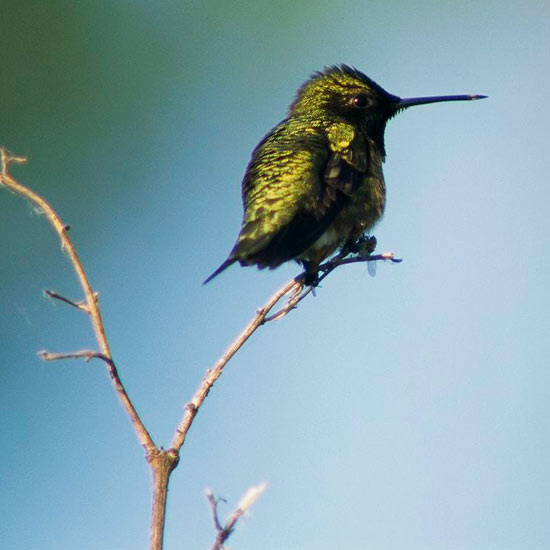
Hummingbirds are attracted to a garden that includes open spaces, allowing them to move freely from one nectar source to another. A yard that's one-fourth shaded, one-fourth partially shaded, and the rest in open sun is ideal. Most favored flowers for hummingbirds grow in full sun.
Discover flowers that attract hummingbirds.
Curved beds and borders allow hummingbirds to approach blooms from several sides. Keep shorter flowers in front of tall ones to give hummingbirds easy access to their favorite flowers.
Hummingbirds actually spend most of their day quietly perched in trees or shrubs. However, to maintain their high metabolism, which is the highest of any warm-blooded animal except shrews, they must feed every 10-15 minutes. One hummingbird can visit hundreds of flowers each day in search of food.
Providing places for hummingbirds to perch can keep them in your yard. Males perch almost anywhere in the open -- on twigs, clotheslines, and overhead wires. Females and immature birds prefer to remain hidden among trees, shrubs, and vines. At night when they can't feed or when they enter a period of stress, hummingbirds have the unusual ability to slow their body functions, calming their heartbeat from as many as 1,260 beats per minute to 50.
If your yard space is limited, consider plants that do double duty for food and shelter, such as citrus, cape honeysuckle, desert willow, weigela, flowering quince, and beautybush.
continue reading below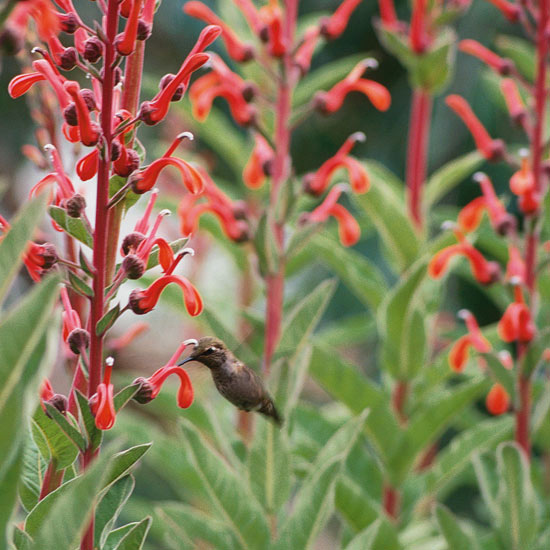
Hummingbird flowers evolved at the same time as hummingbirds, developing specific features that don't allow access to other birds. The best flowers are tubular, scentless, brightly colored (often red, orange, or blue), and grow where it's easy for the birds to hover and sip. Some flowers are shaped to accommodate short or long bills of specific hummingbird species.
Variety is key to hummingbird happiness, too. Try to offer many different kinds of flowers over the longest possible season. You wouldn't want to eat the same food every day, right?
For migrating hummingbirds, flowers that open in spring and late summer are vital food sources. Year-round bloom is important in mild-winter regions of the West and along the Gulf Coast, where some species overwinter.
They're not particular about differentiating between annuals, perennials, and vines.
Mandevilla is a top vine for attracting hummingbirds. Learn more!
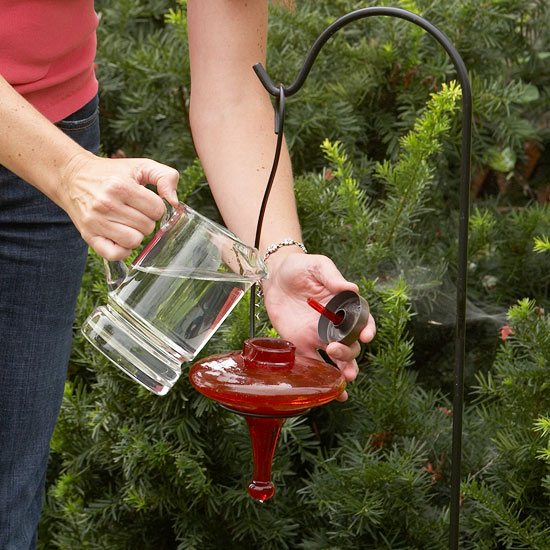
Besides providing nectar-producing plants, you can offer nutrition from a hummingbird feeder. The standard hummingbird feeder recipe closely approximates flower nectar:
4 parts water
1 part sugar
To make food for hummingbirds, first mix the ingredients. Boil for two minutes to remove impurities in the sugar and water. Don't boil longer; evaporation of more water can make the solution stronger, which can be bad for the birds' health. Cool the hummingbird recipe solution before filling the feeder. Store extra solution in the freezer; thaw to use in the next cycle.
Learn how to attract beneficial bugs to your yard.
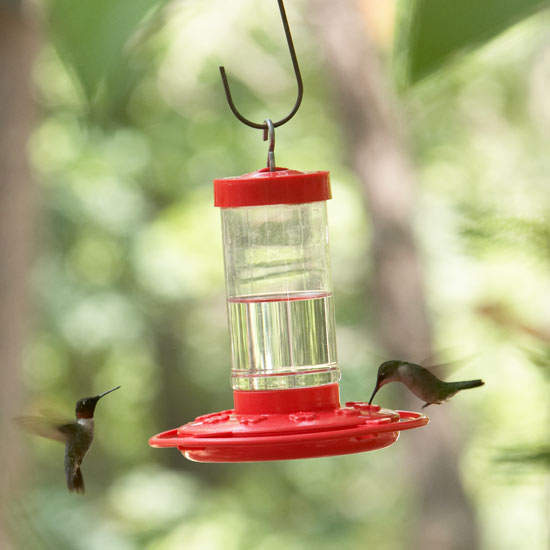
Don't substitute sugar with honey in the hummingbird feeder recipe; the solution spoils quicker and may contain bacteria that can cause a fatal fungal disease. Also avoid artificial sweeteners for the hummingbird recipe: They provide no calories and hummingbirds need lots of calories to keep them going.
Adding red food coloring to the hummingbird feeder recipe is unnecessary; most hummingbird feeders are made from red plastic or glass to help attract the birds. Also, chemicals in the food coloring may be harmful to the birds' health.
Clean hummingbird feeders at least once every three days in hot weather or every week in cool weather so harmful bacteria doesn't build up. Compost any unused hummingbird food and rinse the feeder with water. If you see mold, add a splash of vinegar and grains of uncooked rice to the water and shake vigorously to dislodge it. Remove the vinegar and rice and rinse carefully with clean, warm water. If you see any remaining dark spots, scrub them off with a toothbrush or bottle brush.
If your hummingbird feeder is going unvisited, pay attention. It's probably because your hummingbird feeder recipe sugar solution has gone bad. Clean the feeder carefully, refill with fresh sugar-water, and offer it again.
Contrary to popular belief, hummingbirds can't survive on nectar or sugar solutions alone. Insects are an essential source of protein.
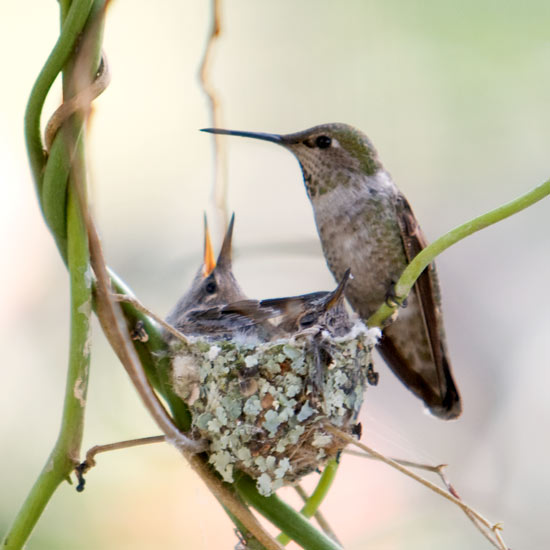
Once you invite hummingbirds to your garden, they will return from migration, seeking flowers in the same places they visited the year before. If you no longer provide them with food, they'll search out a new source of food. If you must be away during critical periods, such as early spring when flowers are scarce or during nesting periods, ask a neighbor or friend to refill your feeders so the birds don't go hungry.
Along with a source of food, hummingbirds also need a water source. Each day, they take in as much as eight times their body weight in water. Much of this comes in the form of nectar, but they also sip from dew-soaked leaves and other sources.
Hummingbirds delight in flying through a fine mist from a sprinkler, but avoid most birdbaths, which are too deep. An elevated birdbath (since they avoid coming to the ground to drink or bathe) with very shallow water levels may appeal to them.
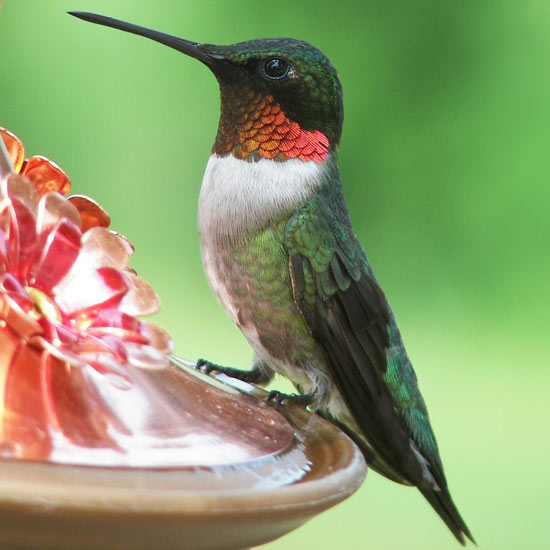
Begin feeding hummingbirds in spring as they migrate to your area. Because the birds depend on protein from insects, migration typically occurs after bug populations have built up from the winter season. In mild-winter areas where the birds may not migrate, gardeners can mix up the hummingbird feeder recipe and give it to the birds all year long.
Copyright © www.100flowers.win Botanic Garden All Rights Reserved